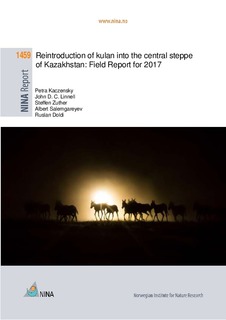Reintroduction of kulan into the central steppe of Kazakhstan: Field Report for 2017
Research report

View/
Date
2018Metadata
Show full item recordCollections
- NINA Rapport/NINA Report [2341]
Abstract
Kaczensky, P., Linnell, J. D. C., Zuther, S., Salemgareyev, A. & Doldin, R. 2018. Reintroduction of kulan into the central steppe of Kazakhstan: Field Report for 2017. NINA Report 1459. Nor-wegian Institute for Nature Research.
This report summarises field activity during 2017 for the project “Reintroduction of kulan to the central steppes of Kazakhstan”.
(1) In June 2017 the project team visited both the capture site in Altyn Emel National Park and the release site on the Torgai steppe. The objective was to make final preparations for the planned capture and transport of kulan in the autumn. The main activities included planning the location of the capture corral, checking the helicopter and design of transport boxes, and making final adjustments to the acclimatisation enclosures. In addition, meetings were held with the local protected area staff and the central responsible committee in Astana.
(2) A series of interviews were conducted with local residents in the release site to get some insights into their attitudes towards kulan and their reintroduction. These indicated that people were generally positive or neutral to the proposed activities, but identified several areas where it will be necessary to focus our communication. These results were then used to fine-tune an education and outreach campaign primarily aimed at local school children and residents.
(3) A rapid assessment was conducted of kulan status in Barsa Kelmes nature reserve on the former Aral Sea, which also included the collection of faecal samples for genetical analysis. This area represents a potential source of animals for future translocations as well as being important to consider within the context of a national kulan conservation plan.
(4) In October 2017 the project team successfully captured 47 kulan in the capture corral in Altyn Emel. Of these, 12 were immobilised and boxed for transport. Two adult mares were released back into Altyn Emel because of adverse stress reactions. Both animals survived and are con-tributing valuable data on the ecology of the source population. Out of the 10 that were trans-ported, 1 foal had to be euthanised on arrival. The other 9, 1 stallion, 4 foals and 4 mares, were released into the largest acclimatisation enclosure and are currently doing well, pending their release in spring 2018.
The experience from 2017 has demonstrated that all steps of the process, capture, transport and release into the enclosures work well, and has identified many areas where improvements can be made to procedures for the 2018 transport which will try to transport 16-18 animals.